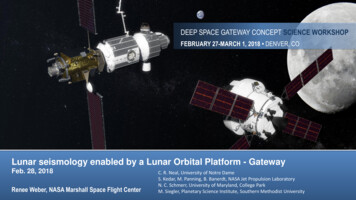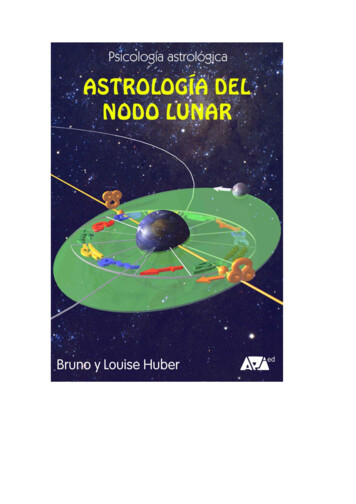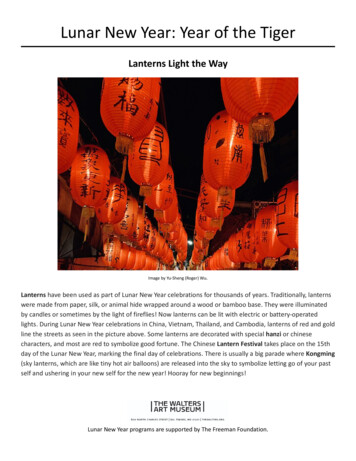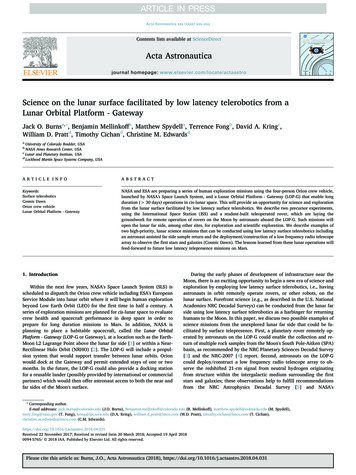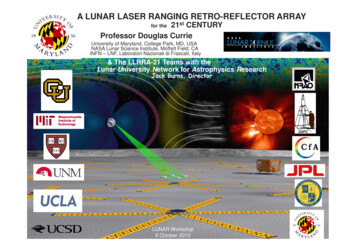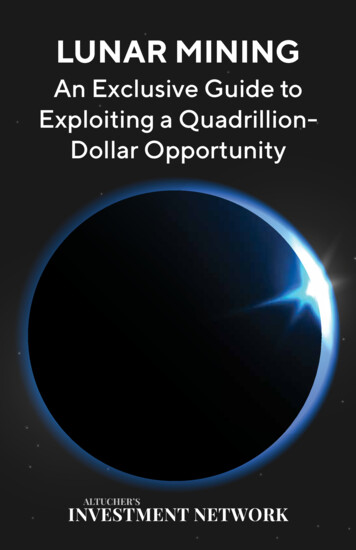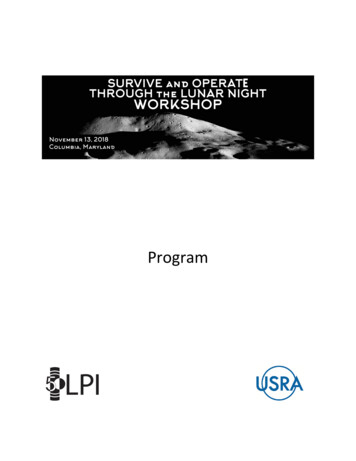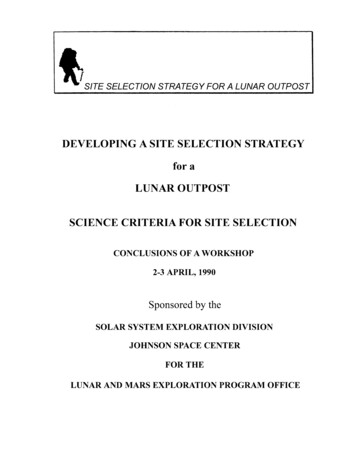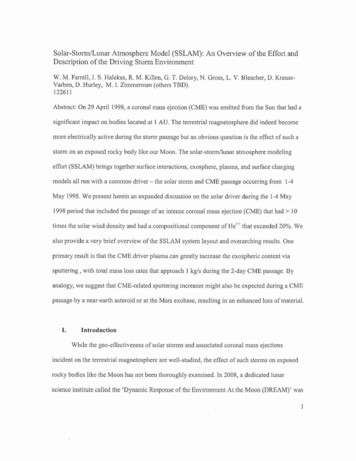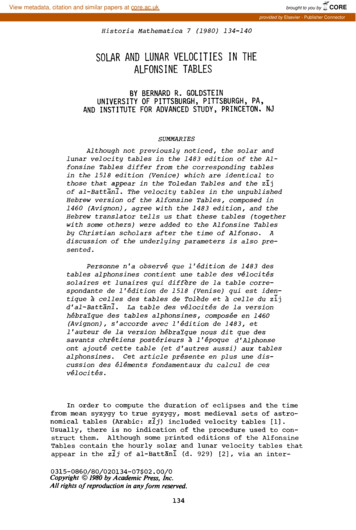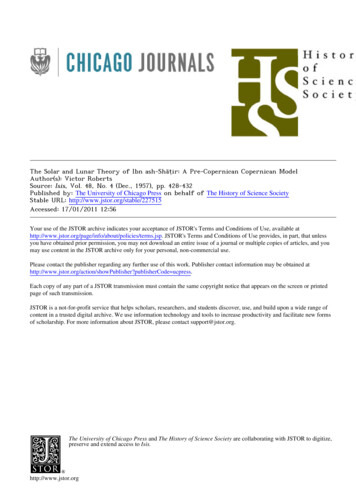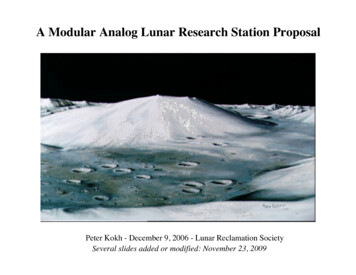
Transcription
A Modular Analog Lunar Research Station ProposalPeter Kokh - December 9, 2006 - Lunar Reclamation SocietySeveral slides added or modified: November 23, 2009
Vertical? -- or Horizontal - Our Design Philosophyis “Modular” as a “real” outpost would beconstantly expanding in space and functionality
An Analog Outpost should be Modularjust as a real Lunar Outpost would be,able to grow in open-ended fashion
a Regolith-covered Cylinder anda Regolith-covered Quonset Hutlook very much alike from the outside
A Quonset hut could also be interpreted asa special kind of hybrid rigid-inflatableHybrid Rigid “Quonset” InflatableFits in Space Shuttle Payload Bay[1] Hinged 3-section floor deck.[2] Uninflated Quonset roof/wall[3] Uninflated floor support pontoons[4] Inflated Quonset roof/wall[5] Inflated floor support pontoons[6] In transit position of docking module[7] Docking tunnel in end wall[8] Downward air pressure on hinges[9] Counterbalance pressure on hinges[10] Contingency stiffening bars[11] Representative pull-up feature[12] Ground contour before shielding
A Quonset Module Shell is inexpensive
An idea of the Quonset interior volume
Modular Architecture Modular Biospherics:Integrating biosphere components in every module, ratherthan as a closeted afterthought, allows the physical OutpostComplex & Biological Biosphere to grow in step together
Modular Biospherics: Biosphere components caneven be integrated into the hallways and connectorsthat tie the complex together as a living whole.
Modularity creates options to experimentwith different utility systems as well
Phase I of a Modular Analog Outpost
A “Green Hub” at the Station’s busiest intersection
Phase II Expanded Analog Moonbase
Phase IV: More Agricultural - Biosphere SpaceA 2nd “torus” or “ring mold” Greenhouse
The South Pole Food Growth Chamber
Tele-robotic “ring mold” Greenhouse conceptWould free lunar personnel for other duties
Overall Site Plan: a main “surface” outpostand an “annex” in a nearby lavatubeor in an abandoned “dry” mine gallery
The Lavatube “Annex” would be used forDayspan/Nightspan Operations Research
Alternatives to an underground spacefor Dayspan/Nightspan Simulation
A More Expensive Dayspan/Nightspan Simulation
An Alternative “Mobile-Modular” Approachbeing pioneered by the Calgary Space Workers
Mars Analog ResearchMoon Analog ResearchProgram Goals vs. Program GoalsDemonstrate value of human-roboticMars exploration at 1st landing The 6 Apollo Missions had alreadydemonstrated this on the Moon Neither FMARS or MDRS hasattempted to demonstrate modularexpansion into a more functionaloutpost, use of local resources, theuse of shielding against the cosmicelements and Mars weather, or ofany kind of life support system.Demonstrate the technologies neededto stay on the Moon, and expand Test modular expansion languages Modular biosphere expansionallowing comparison of differinggraywater systems, living walls etc. Site preparation technologies Shielding technologies Incorporation of lunar materials Semi-automated food production Site maintenance, storage systems Mating production with lunar cycle
Some of our research program flows from ourmodular design philosophy. Other researchvectors will depend on our site location. A vegetation free, rock, gravel,and/or a sandy location [a “bigsandbox”] would allow practicalexperiments with site preparation,teleoperated equipment, shieldingemplacement, and more.Proximity to basaltic areas wouldallow experiments with this earlylunar industry.Proximity to a dry undergroundarea like a lavatube or abandonedmine gallery would allow us to doexperiments pegged to the lunar29.5 day dayspan/nightspan cycle. Lacking a subsurface environment,the lunar dayspan/nightspan cyclecould be simulated within a largebuilding closed to external light. Any kind of terrain will demanddevelopment of appropriate warehousing and recycling systems No site is perfect, and, for practicalreasons, we have to “pick ourbattles.” Yet with ingenuity we canuse most any available site toadvance our preparedness for earlyoperations on the Moon.
Analog Moonbase Research ProgramPushing the Limits of Teleoperation
Analog Moonbase Research ProgramExperimenting with new type Vehicles
Analog Moonbase Research ProgramTesting various Shielding Options
Analog Moonbase Research ProgramShielded Canopies, Hangers, “Ramadas”
Analog Moonbase Research ProgramShielding: from blending in to “standing proud” Putting shielding directly overhabitat structures allows the “molehill” complex to blend into themoonscape, as if it belongs.Another way to say “we belong” butwith “pride” is to create a wall oftextured panels (basalt, concrete, etc.)that by origin and coloration will also“belong” but at the same time bear thestamp of our arrival.Inspired by cliffs in Utah, a talus slopeberms the base of the structure and amound of moondust covers the topThis treatment might be just right toshowcase and identify the Command& Communications Structure
Analog Moonbase Research ProgramTesting various “sunlighting” systems
Analog Moonbase Research ProgramTesting Periscopic Window Systems
Analog Moonbase Research ProgramErgonomics of various Layout Options
Outfitting a “Quonset” as the Crew Dormwith comfortable, quiet “staterooms”
Analog Moonbase Research ProgramDust Control Systems & Dust Management
Analog Moonbase Research ProgramMaximizing use of Early Lunar Materials
Analog Moonbase Research ProgramEarly Lunar Materials for Decor
Analog Moonbase Research ProgramExperimenting with Lunar Fuels & Engines
Analog Moonbase Research ProgramExperimenting with Biosphere Options Alternative Black- Graywater Systems in each Module Alternative Living Wall Systems in each Corridor Alternative Plant Bedding/watering/fertilizing Systemsin the Greenhouse(s) and Living Wall units Alternative nightspan Plant Lighting Schedules Alternative Plant Lighting Systems Alternative Plant Irrigation & Nutrition Systems
Analog Moonbase Research ProgramTesting robotic and teleoperated Agriculture Systems
Analog Moonbase Research ProgramStoring Dayspan Power for Nightspan Use
Analog Moonbase Research SystemExperiments with Operational Scheduling forDayspan and Nightspan power availability
Analog Moonbase Research Program:Experimenting with Nightspan Plant Lighting
Analog Moonbase Research ProgramDiversification of Early Frontier Vegetarian Menus.
Analog Moonbase Research ProgramAn Effort of Several Teams
Analog Moonbase - Public OutreachStudent Involvement Programs
Public Outreach Program - Visitor’s Center
Analog Moonbase Research ProgramWhat else can we do?What else do we NEED to do?Your suggestions are welcome!This will be a cooperative projectMoon Society - National Space SocietyLunar Reclamation Society - Oregon L5 Societyand several other collaborating organizations
Your Comments & Feedback are WelcomePeter Kokh - kokhmmm@aol.compresident@moonsociety.org(subject line: “analog moonbase ideas”)MMM1630 N. 32nd StreetMilwaukee, WI 53208-2040
A Quonset hut could also be interpreted as a special kind of hybrid rigid-inflatable Hybrid Rigid “Quonset” Inflatable Fits in Space Shuttle Payload Bay [1] Hinged 3-section floor deck. [2] Uninflated Quonset roof/wall [3] Uninflated floor support pontoons [4] Inflated Quons
